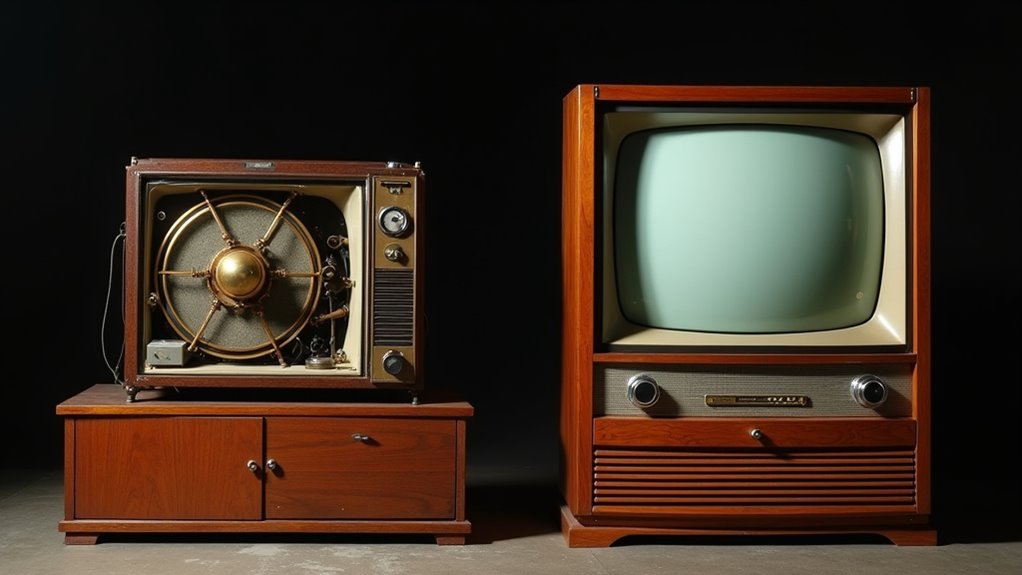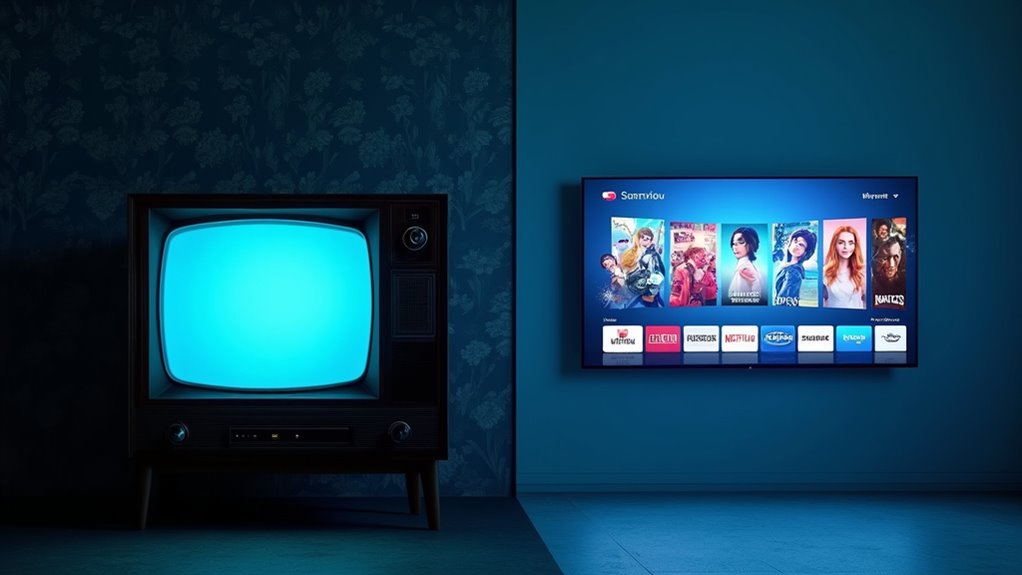Television’s evolution revolutionized entertainment, progressing from mechanical prototypes by Baird and Jenkins to today’s internet-connected smart displays. The introduction of color broadcasting in the 1950s marked a pivotal shift, while HDTV’s crystal-clear images in the late 1990s set new viewing standards. The rise of streaming platforms and smart TV technology transformed traditional viewing habits, with services like Netflix reshaping how audiences consume content. This remarkable journey from flickering images to immersive experiences only scratches the surface of television’s transformative impact.
From Mechanical Dreams to Electronic Reality

While early pioneers dreamed of transmitting moving images through the air, the path from mechanical television to electronic reality was anything but smooth.
The first stumbling steps came from inventors like John Logie Baird and Charles Francis Jenkins, who wrestled with clunky mechanical systems that used spinning disks and drums to capture fleeting images. After years of experimentation, Baird achieved a milestone by transmitting the first human face through television. In 1954, NBC brought color into American homes for the first time.
Paul Nipkow’s revolutionary disk laid the groundwork, but these early systems suffered from major headaches – flickering pictures that resembled abstract art more than actual images, lighting requirements that could rival a Hollywood studio, and enough maintenance issues to keep a repair shop in business for decades.
The breakthrough came when Vladimir Zworykin and Philo Farnsworth stepped into the picture, ditching the spinning parts for electronic scanning. Their work with cathode-ray tubes finally delivered what the mechanical dreamers had envisioned: clear, stable images that didn’t require an engineering degree to operate.
The Dawn of Color and High-Definition Broadcasting
After decades of black-and-white broadcasting left viewers yearning for more vibrant entertainment, the dawn of color television in the 1950s ushered in a revolutionary era of visual spectacle.
The battle between CBS and RCA’s competing color systems ultimately crowned RCA’s NTSC standard as victor, thanks to its crucial backward compatibility with existing sets. While early adopters faced steep prices and technical hiccups, by the late 1960s, color TV had transformed living rooms across America into technicolor wonderlands. By the early 1970s, color television sales finally surpassed black-and-white units across North America.
RCA’s winning color TV system revolutionized home entertainment, despite early hurdles, by letting viewers keep their existing black-and-white sets.
The evolution continued with the introduction of high-definition television in 1998, offering five times the resolution of standard broadcasts. Satellite television brought even more viewing options to households in the early 1990s, despite initial challenges with bulky equipment.
Though HDTV’s initial sky-high costs had many viewers clutching their wallets, its crystal-clear picture quality proved irresistible. Japan’s pioneering role in HDTV development helped establish new global broadcasting standards, while innovations like OLED technology continued pushing visual boundaries.
The Digital Revolution: Smart TVs and Streaming Services

As traditional television broadcasting faced increasing competition in the early 2000s, the emergence of smart TVs and streaming services sparked a seismic shift in home entertainment.
The revolution gained momentum when Netflix transformed from a DVD-by-mail service to a streaming giant in 2007, setting the stage for an industry-wide transformation that would reshape how viewers consume content.
The numbers tell the story of this dramatic shift, with smart TV ownership skyrocketing to 79% of U.S. homes by 2024, while streaming platforms became the new entertainment overlords.
Samsung led the charge in smart TV innovation, introducing cutting-edge features like 4K resolution, OLED displays, and AI-powered recommendations that made traditional cable boxes look like relics from a bygone era.
The global smart TV market is expected to reach an impressive 668.53 billion dollars by 2033, highlighting the explosive growth of this technology sector.
The integration of voice control and smart home capabilities turned these once-simple screens into sophisticated entertainment hubs, while streaming services like Disney+ and Hulu delivered content libraries that made channel-surfing feel positively prehistoric.
This shift in viewing habits has dramatically impacted traditional TV methods, which now account for only 33% of viewing share, marking a significant decline from just three years ago.
Frequently Asked Questions
How Much Did the First Television Set Cost When It Was Released?
The first commercially available television sets in the 1930s came with a hefty price tag, ranging from $200 to $600, equivalent to several months’ salary for the average American worker who earned around $1,368 annually.
These early sets, primarily marketed to wealthy consumers and commercial establishments, represented a significant luxury purchase that remained out of reach for most middle-class families until prices began declining in the mid-1940s.
Which Country Had the Highest Number of Television Sets in the 1950S?
The United States dominated television set ownership during the 1950s, experiencing an unprecedented surge from 9% household penetration in 1950 to a staggering 85.9% by decade’s end.
This rapid adoption saw the number of TV sets skyrocket from approximately 6 million in 1950 to tens of millions by 1959, far surpassing other nations’ television ownership rates during this transformative period of broadcasting history.
When Did Television Advertising First Begin and How Much Did It Cost?
Television advertising officially debuted on July 1, 1941, when Bulova Watch Company aired the first legal TV commercial on NBC’s WNBT station.
This pioneering 10-second spot, which aired before a Brooklyn Dodgers-Philadelphia Phillies baseball game, cost a mere $9 – split between $4 for airtime and $5 for station charges.
Despite reaching only 4,000 TV sets in New York City, this modest investment launched what would become a multi-billion dollar industry.
What Was the Average Lifespan of Early Television Sets Before Replacement?
Early television sets had a notably short average lifespan of about 3.5 years, primarily due to the frequent failure of vacuum tubes and CRT components.
These pioneering sets, while revolutionary for their time, demanded regular maintenance and often succumbed to power consumption issues.
The costly nature of repairs, combined with the fragility of components and environmental factors like temperature fluctuations, typically made full replacement more practical than extensive repairs.
How Many Hours per Day Did Early Television Stations Broadcast Programming?
Early television stations operated on remarkably limited schedules, typically broadcasting between 4-5 hours per day in the late 1940s and early 1950s.
The BBC, for instance, aired around 5 hours daily starting at 10 am with scheduled breaks between programs.
As networks expanded and technology improved through the 1950s, broadcast hours gradually increased, though stations would still sign off late at night, often with the national anthem.
